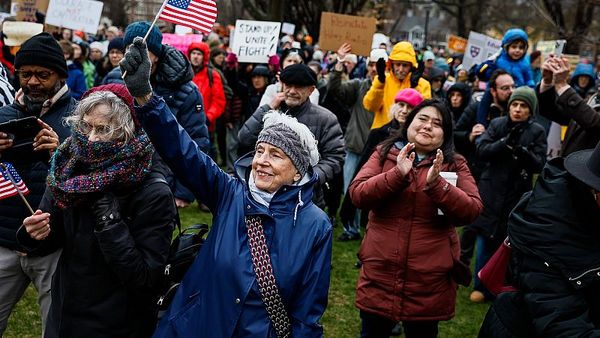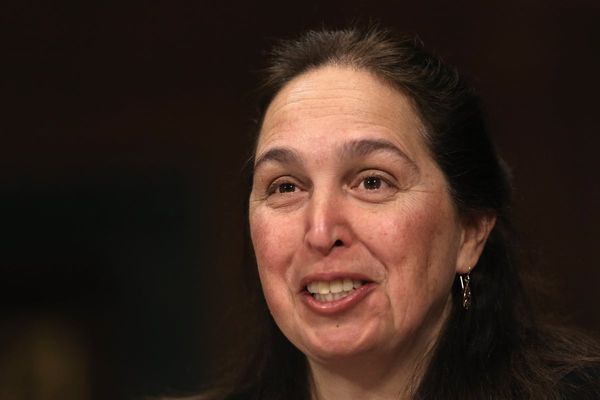
Whenever a Murdoch is in town – or the media mogul’s favourite daughter, News UK boss Rebekah Brooks – the company’s Australian editors try hard to impress.
Brooks, Lachlan Murdoch and News’s global chief, Robert Thomson, flew in ahead of the announcement of a major restructure of the Australian newspaper as early as Monday.
History has shown that nervous editors often save their best stories for the occasion of a “royal visit”, and this week has been no exception.
On Friday the Australian’s website featured no fewer than three stories about a cold case which is being investigated by star reporter Hedley Thomas, of The Teacher’s Pet podcast fame. The podcast, about a woman who went missing in 1993, has been teased all week in what can be described as promotion rather than news.
On Monday the Australian’s editor-in-chief, Michelle Gunn, claimed to have a bigger readership than both the Sydney Morning Herald and the Age – and boasting that the reason for this triumph is “The Australian’s contest of ideas”.
“The Australian’s weekday and weekend readerships now outstrip those of both The Sydney Morning Herald and The Age, as the national masthead continues to grow its audiences while the Nine-owned metro titles shed thousands of readers each month,” a report by media editor James Madden said.
Gunn: “The latest readership figures reflect Australians’ hunger for quality journalism and incisive analysis in turbulent times and cement our masthead’s position at the heart of the national conversation.”
But wait. According to Nine’s reporting of the same Roy Morgan survey, the Sydney Morning Herald is the country’s most-read masthead: with a cross-platform readership of 7.3 million. The Age has readership of 4.7 million. Under another digital only measure, Ipsos rankings for the Top 20 news websites, The Australian had 4,091,000 readers in April while the SMH had more than double that at 8,268,000.
We asked Gunn what the paper meant by the story and a spokesperson clarified that it referred to print only. It would have been nice to tell the readers that.
Circulation used to be the way we tracked the success of newspapers but that was quietly ditched when news went digital and now the metric of “readership” is used, a far less scientific method in which people are surveyed about what they read.
#BREAKING: Ipsos rankings for the top20 news websites in April have just been released. @newscomauHQ stays No1 on 12.4m, only just ahead of @abcnews on 12.26m@GuardianAus had 7.9m readers in April, 460k more than prev month, but drops to 7th behind @SMH, who added 870k in April pic.twitter.com/4Zj1p9oAfc
— Dave Earley (@earleyedition) May 23, 2024
News Corp hops on board AI train
News Corp Australia has embraced AI, increasingly using the technology to replace photography or commission art to illustrate opinion pieces by Andrew Bolt and Joe Hildebrand, among others. But now the roles have been reversed. ChatGPT developer OpenAI has signed a reported US$250m (A$379m) deal with News Corporation to use Rupert Murdoch’s global titles – including the Australian, news.com.au, Daily Telegraph, Courier Mail, the Advertiser and Herald Sun – “in response to user questions and to enhance its products”.
“In addition to providing content, News Corp will share journalistic expertise to help ensure the highest journalism standards are present across OpenAI’s offering,” OpenAI said when it announced the deal on Wednesday.
News Corp’s chief, Robert Thomson, said Murdoch journalism will now “have an integral role in informing audiences around the world in the GenAI age” and the deal acknowledges that there is “a premium for premium journalism”.
But not everyone is confident the deal will have positive outcomes.
The ABC’s veteran digital strategist Craig McCosker said: “If ChatGPT is using News Corp content to ground its answers it will be interesting to see how it answers topical questions about the ABC.”
And the University of Sydney AI and ethics researcher Rebecca Johnson said the deal could create increased polarisation.
“When you train a model, it picks up the embedded values, morals, world views, ideologies and cultural traits that are prominent in the training data,” she told the New Daily.
ACM lawyer resigns
The corporate lawyer who was implicated in the hosting of websites that later published thousands of articles using copy taken from legitimate news outlets has resigned.
James Raptis, who was Antony Catalano’s in-house counsel at Australian Community Media, said the websites were “operated by another person without any involvement or oversight from me”. Company sources told Guardian Australia they believed Raptis when he said it wasn’t him and would stand by him.
A week later ACM’s chief financial officer Chris Hitch told staff Raptis had resigned and would leave immediately.
“I wish to advise the ACM senior legal counsel James Raptis has tendered his resignation from the company,” Hitch said.
“The company has accepted James’s resignation and today will be his final day with the business. I’d like to thank James for his contribution since joining ACM last June. We wish him well in his future endeavours.”
Raptis admitted to setting up and hosting four websites – League Initiative, F1 Initiative, Surf Initiative and AliaVera. But denied he had posted the poor-quality articles apparently using generative AI to disguise them from the original copy.
ABC’s Media Watch program first revealed some stories on the sites carried Raptis’s byline.
NYT seeks new correspondent
Damien Cave, the New York Times reporter who opened the newspaper’s bureau here in 2017, has moved into a new role as an international correspondent writing about Taiwan, China and Ukraine.
This means the New York Times is seeking a new Australia Correspondent, to cover Australia, New Zealand and the rest of Oceania, according to the ad.
The position “requires a broad array of skills and interests, and the ability to master every kind of story we do, including live coverage and explanatory pieces; work that reflects cultural, economic and climate developments; and the distinctive profiles, dispatches and features that help engage our readers with the people and places we cover”.
Cave, for his part, will remain in the country where he has embraced the Sydney lifestyle and which inspired him to write a book: Parenting Like an Australian: One Family’s Quest to Fight Fear and Dive into a Better, Braver Life.
TV reshuffle
The man who has been appointed by Seven to run its news empire, former West Australian newspaper chief Anthony De Ceglie, addressed the troops at Seven News this week.
It was a tough audience for De Ceglie, who has no TV experience but is now responsible for Kerry Stokes’s TV empire of 7News, Sunrise, The Morning Show and Spotlight and had to convince jaded hacks of his vision.
One of his announcements was that he had hired 20-something producer from Nine Gemma Williams to run Spotlight and he urged them to give her a ago, saying she would learn on the job.
Gemma, the daughter of former A Current Affair executive producer Grant Williams, is joining Seven after several years in the Nine newsroom
She also worked for 2GB’s Ben Fordham Live and was assistant chief of staff for Nine News Sydney, but has no experience in reporting or long-form storytelling.
Veteran Spotlight executive producer Mark Llewellyn quit Seven last month after allegations made during the Bruce Lehrmann defamation trial that the network reimbursed their interviewee for money spent on cocaine and sex workers. Seven vehemently deny the allegations.
Meanwhile, former Spotlight producer Taylor Auerbach, who gave the bombshell evidence at the trial, has turned his back on journalism.
Back to school!!!!! I have accepted an offer to enrol in a double degree at Macquarie University, studying Law & Media, starting in July!! 😎🎓✏️
— Taylor Auerbach (@tauerbach) May 23, 2024
Auerbach has announced he is studying for a law degree, which is the same career path taken by one Bruce Lehrmann.
Cheques out
Good news this week that the Walkley awards will ban chequebook journalism after Seven’s Spotlight program was nominated for scoop of the year.
But it has sparked a conversation about which stories in the past have won Walkleys on the back of a paid interview.
The Spotlight interview with Bruce Lehrmann was secured by paying $100,000 for his rent on top of expenses for dining, entertainment and golf trips.
It’s not unheard of in commercial TV to pay for stories, in cash or kind, although the networks usually try to disguise it.
Another Spotlight program won scoop of the year at the Kennedy awards in 2022 for an interview with the husband of Melissa Caddick, without disclosing that Anthony Koletti was paid $150,000 to speak to journalist Michael Usher.
Famous examples of the dark art include Lindy Chamberlain, Thredbo survivor Stuart Diver, Beaconsfield mine disaster Todd Russell and Brant Webb and more recently the family of four-year-old Cleo Smith.







